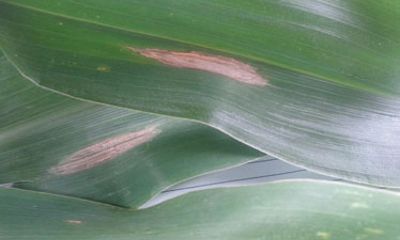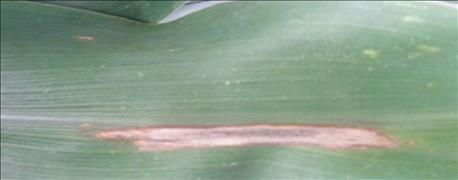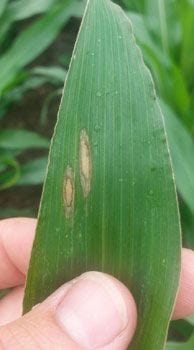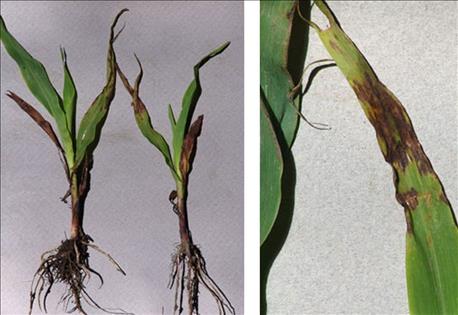June 23, 2015

A number of diseases have been reported and/or confirmed in recent corn samples from around the state. Cool wet conditions have led to the development of several of these. Producers and consultants should monitor the severity of these and other diseases and their potential for impacting yield to assess the need for treatment.
Leaf diseases caused by fungi

Figure 1. Northern corn leaf blight (NCLB) has developed in some eastern Nebraska fields. Large NCLB lesions can develop and cover corn leaves and cost yield. (Photo credit: A. Nelson, Nelson Precision Agronomics)
Northern corn leaf blight
Northern corn leaf blight (NCLB) has been confirmed in several fields in Iowa and in eastern Nebraska (Figures 1 and 2). Cool to moderate temperatures and moisture favor infection by Exserohilum turcicum, the fungus causing this disease. Weather conditions, including cloudy days, moderate temperatures (64-81°F), high humidity, and frequent rainfall will favor further infection and spread of this and other fungal pathogens that survived in infected corn residue. Like most other diseases caused by pathogens in residue, lesions may develop on the lower leaves first and continue to develop on leaves higher up the plant as long as conditions are favorable. NCLB lesions can grow to be larger, cigar-shaped lesions (Figure 1) with rounded ends. These can be confused with Goss's bacterial blight lesions; however, NCLB lesions can develop fungal spores that make them appear darker and/or dusty.

Figure 2. Lesions may appear small and grow to large, cigar-shaped areas. (Photo credit: A. Nelson, Nelson Precision Agronomics)
Management
Development and spread of NCLB prior to tasseling could substantially reduce corn yield, particularly as lesions develop and expand, killing leaf area that's necessary for grain fill later. It is most important to protect leaves at the ear leaf and above that contribute the most to grain fill. In some fields, the disease has already reached leaves 8-9. With the early development of NCLB now, it might be necessary to make a foliar fungicide application to slow disease spread in susceptible hybrids and protect uninfected leaf tissue.
~~~PAGE_BREAK_HERE~~~
Lesions develop several days after infection occurs. Thus, it is possible that one to two leaves are already infected above the highest leaf on the plant that has recognizable lesions. To determine if a fungicide application is economical for you, consider:
• corn price,
• yield potential,
• cost of treatment, and
• disease severity.
Corn disease control ratings (Table 1) for a number of commercial fungicides were made by the multi-state Corn Disease Working Group.
No treatment thresholds have been established for NCLB. However, you can assess your risk for developing yield-limiting disease severity by considering the high-risk factors listed below. Having more of these high risk factors will increase the likelihood of increasing severity of NCLB and getting a return on the cost of a fungicide application:

Figures 3 (L) and 4 (R). Anthracnose leaf blight has developed in the lower leaves of some corn in Nebraska, but usually does not require treatment.
• Poor hybrid disease rating(s) for NCLB (consult seed catalog or company representatives for ratings)
• Early disease development, especially during pre-tassel growth stages
• Continuous corn
• History of severe NCLB
• Substantial corn residue
• Weather forecast for humid/wet weather and moderate temperatures
Scout fields now and frequently to monitor for development of NCLB and other diseases. The NCLB rating provided by your seed company for your hybrid(s) will help you anticipate whether the disease may become severe. In fields currently affected by NCLB, it will be important to consider this disease in the future when making hybrid selections and other management decisions. Crop rotation, tillage, and other practices may be particularly helpful in these fields to break the disease cycle. For more information see Northern Corn Leaf Blight, a publication from Purdue University.
Anthracnose Leaf Blight
Anthracnose leaf blight has developed in the lower leaves of seedlings across the state (Figures 3 and 4). This common disease thrives during cool, wet springs. Management is usually not necessary at this stage. The same fungus causing leaf blight in seedlings now can cause leaf blight, stalk rot, and/or top dieback later in the season. It overwinters in infected crop residue.
~~~PAGE_BREAK_HERE~~~
Bacterial Diseases
Bacterial diseases in corn have also been confirmed and reported in fields around the state, especially in fields where corn was wounded during recent severe weather. In particular, Goss's bacterial wilt and blight and bacterial stalk rot have been confirmed in seedling plants submitted to the UNL Plant & Pest Diagnostic Clinic. Current moderate to warm weather conditions will continue to support spread and development of these diseases, particularly where severe weather has wounded plants.
Affected corn may have one or more of the following symptoms:
• water-soaked lesions,
• wilting,
• discoloration,
• internal decay, and sometimes
• unpleasant odor.
Systemically infected plants will often be discolored inside the stems. Other symptoms on the leaves may appear somewhat different than the classic leaf blight symptoms usually observed with Goss's wilt, such as the dark freckles near the edges of lesions. Glossy exudate may be visible on the surface of leaves and is common in plants with Goss's wilt, but may occur with some other bacterial diseases, too.
Since the pathogens causing these diseases are at least somewhat common in fields, it is possible for plants to have more than one disease. Since several diseases may appear similar, it is necessary to submit a sample(s) for diagnosis and confirmation. Infected seedlings have little chance of survival once the pathogen becomes systemic.
For more information, please see the UNL NebGuide, Goss's Bacterial Wilt and Leaf Blight of Corn (G1675).
Diagnosing corn diseases
For help diagnosing a plant disease, submit a sample to the UNL Plant and Pest Diagnostic Clinic.
For additional information, contact University of Nebraska Extension Plant Pathologist Tamra Jackson-Ziems at [email protected] or Extension Educator Kevin Korus at [email protected].
Source: UNL CropWatch
You May Also Like




